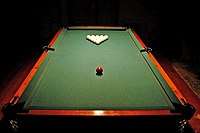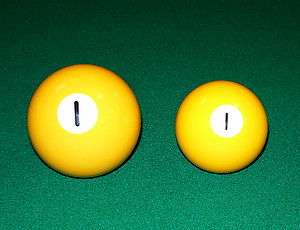Russian pyramid
Russian pyramid, also known as Russian billiard (Russian: ру́сский билья́рд, russky bilyard, French: billard russe) is a form of pocket billiards played on a modified snooker table with narrower pockets. It is popular across Eastern Europe as well as countries of the former Soviet Union/Eastern Bloc. A variant with colored balls modeled on those of pool is known as Russian pool. In Western countries, the game is known as pyramid billiards, or simply pyramid within professional circles.

Equipment
- Table: Playing-surface sizes vary. The usual range (the foot measurements are traditional approximations, the metric more precise) include: 7 × 3.5 foot (198 × 99 cm); 8 × 4 ft (224 × 112 cm); 9 × 4.5 ft (254 × 127 cm); 10 ×5 ft (295 × 147 cm); up to 12 × 6 ft (355 × 177.5 cm), the same size preferred for snooker, and the official tournament size. The slate used in Russian pyramid tables are significantly thinner than those of pool and snooker tables, but are occasionally heated, similar to carom billiards table. In the United States, it is common for amateur and non-professional players to play Russian pyramid on a regular pool table, often in pool halls or private homes.
- Balls: There are sixteen balls (fifteen numbered balls and a cue ball), as in pool, but the numbered balls are white, and the cue ball is usually red or yellow. Up to 70 millimetres (2 3⁄4 inches) in diameter, they are larger and heavier than Western billiard balls; the official tournament size is 68 mm (2 11⁄16 in). Smaller balls – e.g., 63 mm (2 1⁄2 in), 60 mm (2 3⁄8 in), and 57 millimetres (2 1⁄4 in) (regular pool ball size) – are available for smaller table sizes.
- Pockets: The corner pockets are only 3 mm (approx. 3⁄16 in) wider than the diameter of the ball. The middle pockets, however, are 12-13 mm (approx. 1⁄2–3⁄4 in) wider than the diameter of the ball. This makes the game's mechanics like an oversized version of snooker, requiring greater precision to pocket a ball in such tight pockets than in pool, which has a much larger pocket size in relation to the balls.
- Cues: Due to larger ball size, the cues used for Russian pyramid are slightly thicker and heavier than those of pool cues, and the tip diameter is wider (up to 15 mm), in comparison to 10-13 mm used in pool cues. Specialty shots like massé and jump shot are usually more difficult to perform with a Russian pyramid cue, due to its heavier nature. These shots are also not allowed in official tournaments, doing so may result in a foul.
Rule variations

There are several rule variations of Russian pyramid. All games begin with fifteen numbered white balls racked in a pyramid pack, as in straight pool, eight-ball and blackball. Players may pocket any object balls on the table regardless of number, and the first player to pocket eight or more balls wins the frame. In addition, shots do not have to be called. Depending on the game variant some specific balls may have to be in specific positions within the rack. The first player firmly breaks the rack with the cue ball from just in front of the baulk line. The three most common varieties are the following, each of which has slight local variations on the rules:[1]
- Free pyramid (also known as American pyramid)
- Any ball may be used as the cue ball. Players can pocket the ball they struck if it hits another ball first, with the goal being to carom (cannon) the struck ball off of one or more other balls into a pocket. Should the struck ball be pocketed without striking any other balls, the shot is a foul and that ball is spotted behind the baulk line.[2]
- Dynamic pyramid (also known as Siberian pyramid or Nevsky pyramid)
- Only one ball is the cue ball. Players can pocket the cue ball with a carom shot off another ball and then the scorer must choose an object ball to be taken off the table. The player then has ball in-hand and may place it anywhere on the table but may not pocket it until the next stroke, otherwise it is a foul.
- Combined pyramid (also known as Moscow pyramid or combo pyramid)
- Rules are the same as in dynamic pyramid, except that, after the cue ball is pocketed, the cue ball is spotted between the head rail (bottom cushion) and head/baulk, but not on top of that line; from here until the next stroke, balls can be only pocketed in the side and far-corner pockets. In pool, this part of the table is called the kitchen and the Russian equivalent is дом (dom), 'house'.
- Classical pyramid
- Rules are similar to fifteen-ball pool. The object is to score at least 71 points. For each correctly pocketed object ball, the player wins the number of points on the ball (except for 1-ball, which scores 11 points). The last remaining ball on the table, regardless of its number, is worth 10 points. The total number of points is 130.[3]
Russian Pyramid World Championship
Since 2000, Russian Pyramid World Championships have been held for Russian pyramid. The world governing body for the sport, establishing published rules and equipment standards, is the International Pyramid Committee, with its largest regional affiliate being the European Pyramid Committee.
In popular culture
The so-called "American" version, free pyramid, adapts well to use in fiction because of its simple rules (i.e., the plot does not have to side-track into complicated gameplay explanation), and has featured prominently in notable Russian films such as The Meeting Place Cannot Be Changed (1979) and The New Adventures of the Elusive Avengers (1968). An episode of the popular animated television series Kikoriki has two characters playing the game. Main characters of Dead Man's Bluff, or Zhmurki (Russian: Жмурки) play Russian pool in the bar scene.
Nowadays, the game is increasingly popular to be simulated as a video game, especially mobile game on Android devices. Many developers and producers have developed various Russian pyramid video games, with varying degrees of realism.
"Russian pool"

Colored numbered balls for playing eight-ball, nine-ball and other pool games on Russian billiards tables are also produced. The balls are 68 mm (2 11⁄16 in) in diameter, like the standard onea for Russian pyramid, and thus much larger than the American-style balls they are patterned after (as illustrated in the comparison image).
References
- "Free Pyramid rules - East European Billiard Council". ebc-billiard.com. Retrieved 2020-02-23.
- http://www.billiard-prime.com/en/poleznaya-informaciya/pravila-russkoy-piramidy/classic-piramid.html
